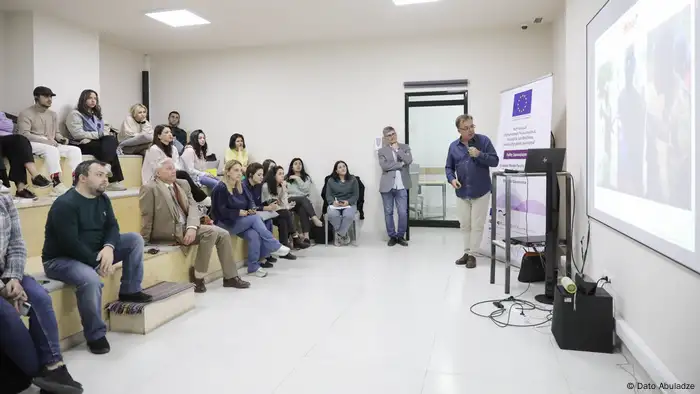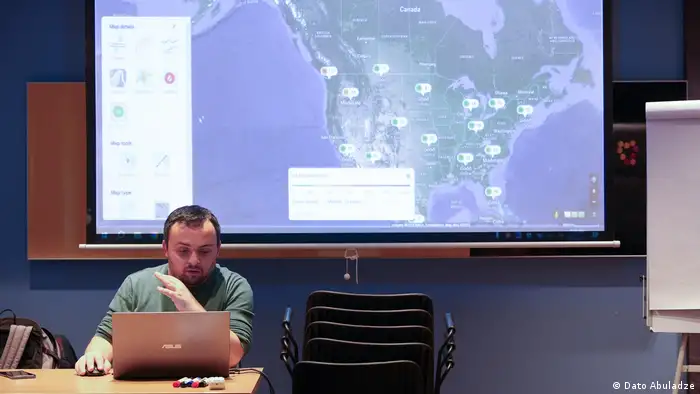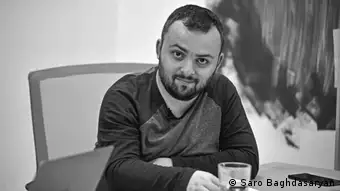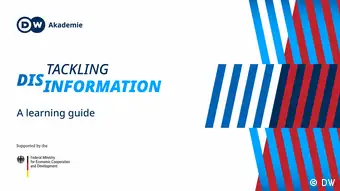Tackling disinformation: A learning guide
How Armenia's Hetq media fights disinformation and divisions
Here's how the independent media outlet Hetq gains its audiences' trust in a tough media landscape hit by Russian trolls and deeply divided local media.
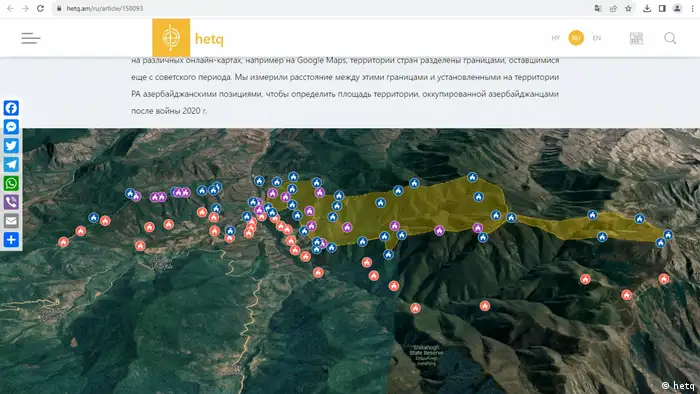
During the 2020 Nagorno-Karabakh conflict, Hetq used open-source data to determine the area of the territory occupied by the Azerbaijanis after the 2020 war
Since its foundation in 2001, Armenian media outlet Hetq has built a reputation as the country’s foremost investigative media through participating in global investigative collaborations like the Offshore Leaks and Panama Papers.
For years now, Hetq, which means trace in English, has applied a multipronged approach to fighting disinformation. The head of the fact-checking team, Vahe Sarukhanyan, explains in an interview with DW Akademie how this approach works.
DW Akademie: Why is disinformation a pressing issue in Armenia?
Vahe Sarukhanyan: Disinformation in Armenia has longbeen a concern. But recent events, such as the COVID-19 pandemic, Armenia-Russia relations and especially the Nagorno-Karabakh conflict* with neighboring Azerbaijan, have increased the country's vulnerability to disinformation. Due to the changing geopolitical environment, Armenia is often the target of foreign, especially Azeri and Russian disinformation, operations.
But disinformation is rampant because of internal factors as well. One of the main reasons behind this is, of course, the low level of media literacy, particularly on social media platforms where manipulation is widespread. In the highly polarized domestic political life, various political groups often run their own disinformation operations on social media, which is what most Armenians use for being informed.
The government is also part of the problem. Under the threats of war, Armenia's government has become more cautious and closed, putting national security and defense interests ahead of openness in terms of information. It often limits the public's access to state-held information by responding to requests with considerable delays or refusing to answer them altogether, especially information related to the army, military operations or the Armenia-Azerbaijan frontline. Often journalists need to verify official information or announcements.
For example, during the 2020 Nagorno-Karabakh conflict, when martial law created especially challenging circumstances for journalists, it was easy to see that there were two fronts in the information warfare: Azerbaijan's media were reporting one story line and the Armenian government another. Neither version really reflected what the journalists on the ground were reporting about heavy casualties and losses on both sides, like in any war.
*The Nagorno-Karabakh conflict was a long-running dispute between Azerbaijan, in which Nagorno-Karabakh lies, and Azerbaijan's ethnic Armenian majority who lived there. In September 2023, Azerbaijan forces entered Nagorno-Karabakh. The majority of ethnic Armenians fled, and on 1 January 2024, the territory was formally dissolved.
What is the role of mainstream media in Armenia's disinformation landscape?
The mainstream media environment mirrors political divisions so, in some ways, it contributes to the problem rather than offering solutions. Most mainstream media remain in the hands of the government with public media acting like a government mouthpiece. Mainstream private media is divided along political affiliations or the affiliations of businesspeople or oligarchs owning those outlets. Both sides spread their own falsehoods in their media, which we sometimes call "microphones", because they just amplify the party propaganda lines. They unfortunately quickly reach big audiences, so fighting against these waves of disinformation is particularly difficult. By the time these reports are properly verified, the information has already reached many people. The main source of news is social networks, which two-thirds of the population access daily for news.
Against this backdrop, independent media, for example Hetq, Civilnet or Factor, which can operate freely and generally publish online, play a crucial role in combating disinformation. They provide robust and good quality journalistic content that challenges the narratives of state broadcasters and other establishment media.
What does independent media mean in the Armenian media context?
Independence for us at Hetq means that we are both financially and politically independent, thanks to international grants that we receive from organizations like USAID, several embassies in Armenia, British Council, DW Akademie and Germany's GIZ development agency. We don't receive funds from either the Armenian government, pro-government oligarchs or businesspeople supporting the opposition. At different times, different oligarchs have offered bribes in exchange for not publishing the investigation. However, we have consistently refused these offers, emphasizing our commitment to journalistic integrity by providing them with an opportunity to comment. Additionally, there was an offer to purchase our newspaper, which we also turned down.
In terms of our journalistic approach, we are between government and opposition media, reporting with the same standards on everyone, especially when it comes to corruption. In recent years, dozens of criminal cases have been initiated based on our investigations and revelations. Politicians have had to resign because of our articles.
We are a member of the Organized Crime and Corruption Reporting Project (OCCRP), a global investigative network, and we were also part of huge international journalistic collaborations like the Offshore Leaks, Panama Papers, Pandora Papers and Suisse Secrets.
As we keep equal distance from all sides, we know that both government, pro-government forces and the opposition read our site as do businesspeople on both sides. Sometimes they also trust us with confidential information as sources. The phrase "Hetq wrote about it" has become a label of confidence, and our readers sometimes leave comments that half-jokingly suggest our investigative journalists should train members of the law enforcement sector to do their job better or to even stand in for them.
How does the audience perceive independent media?
We know from the audience's reactions, letters and social media comments that they perceive us as a media outlet that is squeezed between two rocks – between opposing political forces. Hetq was founded in 2001, so we have a long history already which allows us to see that we have been able to carve out a stable audience for ourselves. These are people who can differentiate between biased, party-affiliated content, and neutral, independent-minded approaches like ours.
The fact that Hetq participated in international journalistic collaborations I have already mentioned established our reputation: the Armenian public learned that official sources can't always be trusted and good journalists and credible outlets like ours are the ones to which they need to go for factual, verified information.
For all these years, with our approach, we could establish a high-level of trust among our audience, who turn to us when they need unbiased information, or when they want to share information with journalists that they think the public should know. We have up to 300,000 monthly visitors. This is a significant audience in the Armenian context. This audience is not only in Armenia, which has less than 3 million inhabitants, but also Armenians from the global diaspora. According to estimates, less than one-third of the world's Armenian population actually lives in Armenia.
Our audience also knows what challenges we have had to endure because of our independent journalistic approach, and this is also a crucial factor contributing to a higher level of trust in us. They know that we are targeted by physicalattacks,lawsuits, legal threats from politicians and oligarchs, smears and online harassment from elected officials from the ruling party, the opposition and both of their supporters. Pro-government trolls, whom the public often call "zombies," regularly attack independent journalists. Often those same trolls share our articles when we cover their opponents' wrongdoing.
Sometimes we are labeled and smeared on social media because we receive international donor funding, although we have always been transparent about this aspect of the organization. We always emphasize that these donor organizations don't interfere with our reporting. These smears haven't affected our audience figures — our readers judge us by the content we produce and the changes we have been able to generate in Armenia.
What is the biggest challenge in the fight against disinformation in Armenia?
The biggest challenge is still the low level of media literacy in Armenia. We need more media literate audiences who can better navigate in this disinformation environment. Especially challenging is how to reach younger audiences who consume media and news using modern technologies and mostly use social networks as sources of information. We also need to adapt our approaches, distribution channels and formats to engage these younger audiences.
To improve the level of media literacy, we need to do that also among journalists, editors and newsroom leaders who sometimes think of fact-checking as an unnecessary "extravagance." Journalists need to realize that they need these better educated audiences who would keep reading and supporting them.
What is important to note is that despite the challenges with armed conflicts and political turmoil, Armenia's independent media have remained resilient. Independent journalists and fact-checkers remained faithful to their principles. They have not become a part of political camps and did not take financial help from oligarchs.
Hetq's approach to combating disinformation
Produce good investigative journalism and educate a new generation of professionals
- Investigate Hetq is an investigative journalism outlet, and our first and most important mission is to publish hard hitting investigations and good journalism, so that the audience have a choice between reliable information and dis- or misinformation. We have a dedicated fact-checking team which is engaged in monitoring daily events, scrutinizing statements made by officials, examining disseminated information and adapting fact-checking tools to produce reliable content.
- Educate Building on that mission in 2020, we launched an initiative called Hetq Media Factory to educate a new generation of journalists and newsroom leaders in areas like investigative journalism, fact-checking, verification techniques, digital security and promoting the culture of investigative journalism. We believe that having a new generation of highly qualified, social media savvy journalists who produce good-quality content will help Armenia more effectively counterbalance the effects of disinformation.
- Advocate We are actively promoting fact-checking culture in Armenian media through educating and training journalists from numerous media outlets and media-related organizations. Our fact-checking team has been working with regional media outlets assisting them in content creation, offering guidance and providing training courses on various fact-checking tools.
- Write policy Hetq has developed a comprehensive fact-checking policy that outlines editorial standards and principles. This policy serves as a guiding framework for the fact-checking team and the entire editorial staff. During one-on-one consultations and various exchanges, we share this policy with other media organizations that partner with us, and we help them with their own tailor-made fact-checking policies.
- Encourage To further engage Armenian journalists in the practice of fact checking, Hetq has organized two competitions focused on articles produced by using fact-checking tools. The winners of these competitions are rewarded, fostering increased interest in this field and laying a foundation for the development of the journalistic discipline.
- Network We are creating a professional network and a wider community of fact-checkers: In 2021 we initiated the InFact platform for journalists specialized in fact checking, involving a range of media outlets and organizations throughout Armenia. What initially began as a collaborative effort has now evolved into a formal network, institutionalized through a cooperative memorandum. The Facebook-group accompanying this network has also transformed with time. Originally a smaller professional group, it now boasts more than 800 members who are interested in fact checking, would like to learn about ways to counter disinformation and want to work and learn together. Within the group, members exchange experiences, knowledge, tools, materials and resources related to fact checking.
- Go global Hetq is actively engaged in seeking global collaborations for this local fact-checking network, aiming to establish connections with other local or regional fact-checking networks. The group is an important platform to spread the culture of fact checking among wider audiences and to improve the media literacy level of Armenians.
Based in Yerevan, Armenia, Vahe Sarukhanyan is an investigative journalist and fact-checker at Hetq online newspaper. He graduated from the Yerevan State University Faculty of Journalism. As a journalist, he specialized in covering aviation, corruption and uncovering the assets of officials abroad.
This written interview was conducted by Attila Mong. It has been lightly edited for clarity and brevity.
This article is part of Tackling Disinformation: A Learning Guide produced by DW Akademie.
The Learning Guide includes explainers, videos and articles aimed at helping those already working in the field or directly impacted by the issues, such as media professionals, civil society actors, DW Akademie partners and experts.
It offers insights for evaluating media development activities and rethinking approaches to disinformation, alongside practical solutions and expert advice, with a focus on the Global South and Eastern Europe.
DW recommends
- Date 14.04.2024
- Author Attila Mong
- Feedback: Send us your feedback.
- Print Print this page
- Permalink https://p.dw.com/p/4eYf9
- Date 14.04.2024
- Author Attila Mong
- Send us your feedback.
- Print Print this page
- Permalink https://p.dw.com/p/4eYf9

